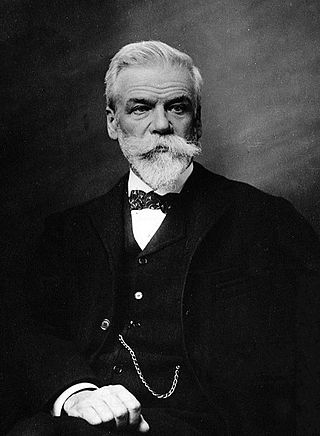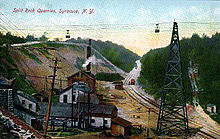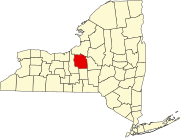
Picric acid is an organic compound with the formula (O2N)3C6H2OH. Its IUPAC name is 2,4,6-trinitrophenol (TNP). The name "picric" comes from Greek: πικρός (pikros), meaning "bitter", due to its bitter taste. It is one of the most acidic phenols. Like other strongly nitrated organic compounds, picric acid is an explosive, which is its primary use. It has also been used as medicine (antiseptic, burn treatments) and as a dye.

Lakeland is a hamlet in Onondaga County, New York, United States. The population was 2,786 at the 2010 census. The community name is derived from its location next to Onondaga Lake.

Amatol is a highly explosive material made from a mixture of TNT and ammonium nitrate. The British name originates from the words ammonium and toluene. Similar mixtures were known as Schneiderite in France. Amatol was used extensively during World War I and World War II, typically as an explosive in military weapons such as aircraft bombs, shells, depth charges, and naval mines. It was eventually replaced with alternative explosives such as Composition B, Torpex, and Tritonal.

Ernest Gaston Joseph Solvay was a Belgian chemist, industrialist and philanthropist.

A shell, in a military context, is a projectile whose payload contains an explosive, incendiary, or other chemical filling. Originally it was called a bombshell, but "shell" has come to be unambiguous in a military context. A shell can hold a tracer.
The Solvay process or ammonia–soda process is the major industrial process for the production of sodium carbonate (soda ash, Na2CO3). The ammonia–soda process was developed into its modern form by the Belgian chemist Ernest Solvay during the 1860s. The ingredients for this are readily available and inexpensive: salt brine (from inland sources or from the sea) and limestone (from quarries). The worldwide production of soda ash in 2005 was estimated at 42 million tonnes, which is more than six kilograms (13 lb) per year for each person on Earth. Solvay-based chemical plants now produce roughly three-quarters of this supply, with the remaining being mined from natural deposits. This method superseded the Leblanc process.

Onondaga Lake is located in Central New York, immediately northwest of and adjacent to Syracuse, New York. The southeastern end of the lake and the southwestern shore abut industrial areas and expressways; the northeastern shore and northwestern end border a series of parks and museums.

The Black Tom explosion was an act of sabotage by agents of the German Empire, to destroy U.S.-made munitions that were to be supplied to the Allies in World War I. The explosions, which occurred on July 30, 1916, in New York Harbor, killed at least four people and destroyed some $20,000,000 worth of military goods. This incident, which happened prior to U.S. entry into World War I, also damaged the Statue of Liberty. It was one of the largest artificial non-nuclear explosions in history.

Clark Reservation State Park is a state park in Onondaga County, New York. The park is in Jamesville, NY, in the Town of DeWitt, south of Syracuse. It was the site of a large waterfall formed by melting glacial ice at the end of the last Ice Age; the plunge basin at the base of the old falls is now a small lake. James Macfarlane described the area in 1879, "On approaching the lake from the turnpike on the south side, the tourist is startled at finding himself, without any notice, on the brink of a yawning gulf, precisely like that of the Niagara River below the Falls, and nearly as deep." Clark Reservation is also noted for its many ferns; it harbors the largest population in the U.S. of American hart's tongue, which is so rare that it was declared endangered in the U.S. in 1989.
There have been many extremely large explosions, accidental and intentional, caused by modern high explosives, boiling liquid expanding vapour explosions (BLEVEs), older explosives such as gunpowder, volatile petroleum-based fuels such as gasoline, and other chemical reactions. This list contains the largest known examples, sorted by date. An unambiguous ranking in order of severity is not possible; a 1994 study by historian Jay White of 130 large explosions suggested that they need to be ranked by an overall effect of power, quantity, radius, loss of life and property destruction, but concluded that such rankings are difficult to assess.

The Silvertown explosion occurred in Silvertown in West Ham, Essex on Friday, 19 January 1917 at 6:52 pm. The blast occurred at a munitions factory that was manufacturing explosives for Britain's First World War military effort. Approximately 50 long tons of trinitrotoluene (TNT) exploded, killing 73 people and injuring 400 more, as well as causing substantial damage in the local area. This was not the first, last, largest, or the most deadly explosion at a munitions facility in Britain during the war; an explosion at Faversham involving 200 long tons of TNT killed 105 in 1916, and the National Shell Filling Factory, Chilwell, exploded in 1918, killing 137.
The Solvay Process Company was an American chemical manufacturer that specialized in the manufacture of soda ash. A major employer in Central New York, the company was key in the origin of the village of Solvay, New York, where it was headquartered.

Ninemile Creek, also known as Nine Mile Creek, is a stream in Central New York in the United States. Its source is at Otisco Lake in the town of Marcellus, from where the creek runs northward for 21.75 miles (35.00 km) through the villages of Marcellus and Camillus to Onondaga Lake in the town of Geddes. Nine Mile Creek is a scenic stream noted for trout fishing.

The 1924 Nixon Nitration Works disaster was an explosion and fire that claimed many lives and destroyed several square miles of New Jersey factories. It began on March 1, 1924, about 11:15 a.m., when an explosion destroyed a building in Nixon, New Jersey used for processing ammonium nitrate. The explosion touched off fires in surrounding buildings in the Nixon Nitration Works that contained other highly flammable materials. The disaster killed twenty people, destroyed forty buildings, and demolished the "tiny industrial town of Nixon, New Jersey."

The Marcellus Formation or the Marcellus Shale is a Middle Devonian age unit of sedimentary rock found in eastern North America. Named for a distinctive outcrop near the village of Marcellus, New York, in the United States, it extends throughout much of the Appalachian Basin.

Munitionettes were British women employed in munitions factories during the time of the First World War.

Stenders Quarry is a 2.8-hectare (6.9-acre) biological and geological Site of Special Scientific Interest in the Forest of Dean, Gloucestershire, England, notified in 1966 and renotified in 1990. The site is designated as an SSSI for its important geological features, although there is also a diversity of plants and animals recorded.
ROF Rotherwas was a Royal Ordnance Factory filling factory, No 4, located in Rotherwas, Dinedor Parish, Herefordshire, England.
Syracuse is a city in Central New York sited on the former lands of the Onondaga Nation. Officially incorporated as a village in 1825, it has been at a major crossroads over the last two centuries, first of the Erie Canal and its branch canals, then on the railway network. The city grew on the back of its salt and chemical industries, and later as a center of manufacturing and engineering. Although its industries have dwindled, the city has remained the economic and educational hub of Central New York, a region with over a million inhabitants; the population of the city, though, has been in decline since peaking in the 1950s.

The Low Moor Explosion was a fire and a series of explosions at a munitions factory in Low Moor, Bradford, West Riding of Yorkshire in August 1916. The factory was manufacturing picric acid to be used as an explosive for the First World War effort and was well alight when the Bradford Fire Brigade arrived. A massive explosion and a series of smaller ones killed 40 people including on-site workers, a railwayman and six firemen who had attended the fire from the Odsal and Nelson Street fire stations.

















